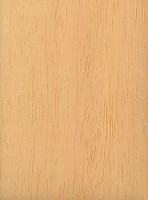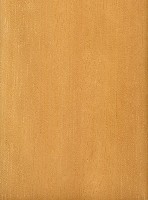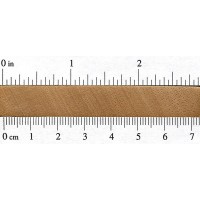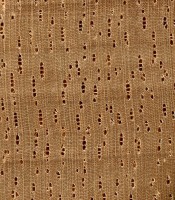 |
Common Name(s): Jelutong Scientific Name: Dyera costulata Distribution: Malaysia, Borneo, and various regions in southeast Asia Tree Size: 100-200 ft (30-60 m) tall, 5-6 ft (1.5-1.8 m) trunk diameter Average Dried Weight: 28 lbs/ft3 (450 kg/m3) Specific Gravity (Basic, 12% MC): .36, .45 Janka Hardness: 390 lbf (1,740 N) Modulus of Rupture: 8,030 lbf/in2 (55.4 MPa) Elastic Modulus: 1,224,000 lbf/in2 (8.44 GPa) Crushing Strength: 4,250 lbf/in2 (29.3 MPa) Shrinkage: Radial: 2.3%, Tangential: 5.5%, Volumetric: 6.2%, T/R Ratio: 2.4 |
Color/Appearance: Heartwood color initially almost white, darkening to a yellowish brown color with age. Sapwood isn’t clearly distinguished from heartwood.
Grain/Texture: Grain is usually straight, or occasionally interlocked. With a uniform medium to fine texture and good natural luster.
Endgrain: Diffuse-porous; large pores in no specific arrangement, very few to few; radial multiples of 2-5 common; growth rings indistinct; narrow to medium rays usually not visible without lens, spacing wide to normal; parenchyma diffuse-in-aggregates.
Rot Resistance: Generally rated as non-durable to perishable regarding decay resistance, and also susceptible to insect attack.
Workability: Jelutong’s low density make it very easy to work with both hand and machine tools. Some gum buildup may occur on cutting tools, but overall results are good. Glues, stains, turns, and finishes well.
Odor: Jelutong can have a distinct sour odor while being worked.
Allergies/Toxicity: Although severe reactions are quite uncommon, Jelutong has been reported to cause skin irritation. See the articles Wood Allergies and Toxicity and Wood Dust Safety for more information.
Pricing/Availability: Not commonly available in North America. The tree has been overharvested in some areas, though it is not actually threatened with extinction. Occasionally available as carving blanks or as lumber. Prices are moderate for an imported species.
Sustainability: This wood species is not listed in the CITES Appendices, and is reported by the IUCN as being a species of least concern.
Common Uses: Patternmaking, carving, and other small specialty wood items.
Comments: Jelutong is a lesser-known Asian species that’s appreciated for its uniform appearance, softness, dimensional stability, and ease of carving. The wood is used in much the same way as Basswood (Tilia americana).
In addition to being utilized for lumber, the tree yields a natural latex when tapped. This latex was used for chewing gum, though nearly all gum is now made from synthetic rubber rather than natural.
None available.
None available.








I really need to flag Jelutong’s dermatitis / allergy risk here, which is far greater than people let on, something I have found out recently to my detriment. Jelutong sensitivity is extremely common – up to 20% of those exposed to it in one study demonstrated both a dermatological response along with a degree of continued or permanent sensitivity even several months after initial exposure. (source: https://pubmed.ncbi.nlm.nih.gov/8807229.) In addition to which, Jelutong (like a lot of tropical species) has a lot of latex in it naturally, and there’s some evidence to show it may either trigger or be linked to… Read more »
my jelutong wood serves me fine. i have had it for 65 years +. This week it will be my anniversery with my wife we bought jeluton for our first house and the house after that. my daughter was also born on a jelutong table.
I have a large slab of jelutong that I’ve stored for some 25 years but now fancy using for a set of chairs.
Will it be strong enough?
I would not recommend it for chairmaking. At best, you could use it for a carved panel in a chair but it is not strong enough to put up with the stresses that it would receive in a chair.
I, having used it for 60 years in the world of professional modelmaking agree with Robert, I think that if used for chairs with fine legs that if someone lent back in the chair the legs would break
We used to make vacuum forming models in the 80´s with jelutong at Volvos Model workshop.
Very popular in model making due to it’s fine grain and ease of cutting and carving.
amazing
fantastic
BRILLIANT
Jelutong is one of the best and easy wood to work with. It can be prevented from insect bites by lacquering the jelutong wood.